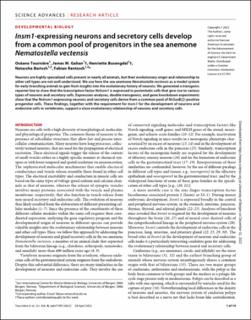| dc.contributor.author | Tourniere, Oceane Barbara | |
| dc.contributor.author | Gahan, James Michael | |
| dc.contributor.author | Busengdal, Henriette | |
| dc.contributor.author | Bartsch, Natascha | |
| dc.contributor.author | Rentzsch, Fabian | |
| dc.date.accessioned | 2022-12-15T14:32:12Z | |
| dc.date.available | 2022-12-15T14:32:12Z | |
| dc.date.created | 2022-06-09T16:49:37Z | |
| dc.date.issued | 2022 | |
| dc.identifier.issn | 2375-2548 | |
| dc.identifier.uri | https://hdl.handle.net/11250/3038096 | |
| dc.description.abstract | Neurons are highly specialized cells present in nearly all animals, but their evolutionary origin and relationship to other cell types are not well understood. We use here the sea anemone Nematostella vectensis as a model system for early-branching animals to gain fresh insights into the evolutionary history of neurons. We generated a transgenic reporter line to show that the transcription factor NvInsm1 is expressed in postmitotic cells that give rise to various types of neurons and secretory cells. Expression analyses, double transgenics, and gene knockdown experiments show that the NvInsm1-expressing neurons and secretory cells derive from a common pool of NvSoxB(2)-positive progenitor cells. These findings, together with the requirement for Insm1 for the development of neurons and endocrine cells in vertebrates, support a close evolutionary relationship of neurons and secretory cells. | en_US |
| dc.language.iso | eng | en_US |
| dc.publisher | American Association for the Advancement of Science | en_US |
| dc.rights | Navngivelse 4.0 Internasjonal | * |
| dc.rights.uri | http://creativecommons.org/licenses/by/4.0/deed.no | * |
| dc.title | Insm1-expressing neurons and secretory cells develop from a common pool of progenitors in the sea anemone Nematostella vectensis | en_US |
| dc.type | Journal article | en_US |
| dc.type | Peer reviewed | en_US |
| dc.description.version | publishedVersion | en_US |
| dc.rights.holder | Copyright 2022 the authors | en_US |
| dc.source.articlenumber | eabi7109 | en_US |
| cristin.ispublished | true | |
| cristin.fulltext | original | |
| cristin.qualitycode | 1 | |
| dc.identifier.doi | 10.1126/sciadv.abi7109 | |
| dc.identifier.cristin | 2030579 | |
| dc.source.journal | Science Advances | en_US |
| dc.identifier.citation | Science Advances. 2022, 8 (16), eabi7109. | en_US |
| dc.source.volume | 8 | en_US |
| dc.source.issue | 16 | en_US |

